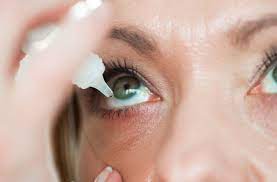Our eyes need tears to stay healthy and comfortable. If your eyes do not produce enough tears, it is called dry eye. Dry eye is also when your eyes do not make the right type of tears or tear film.
What’s in a tear?
Tears are broadly composed of water, oil, and mucin. An abnormality in any of the three layers can cause the tears to evaporate too quickly or fail to spread evenly on the surface of the eye. Since your natural tears are unable to provide sufficient lubrication, a distress signal is sent to the nervous system that results in excessive tear production to alleviate the symptoms. This protective mechanism is known as reflexive tearing, however, it doesn’t always work. Reflex tears are different than natural tears. While natural tears have lipids, mucus, and other nutrients that adds to viscosity and helps maintain them on the eye surface, reflex tears lack that composition and is primarily water which doesn’t stay stable on the eye surface, which causes your eyes to water. Thus, although counterintuitive, tearing or watering eyes can be a sign of dry eyes.
What are the common symptoms of Dry Eye?
Here are some of the symptoms of dry eye.
- You feel like your eyes are stinging and burning.
- Blurred vision, especially when reading
- There is a scratchy or gritty feeling like something is in your eye.
- There are strings of mucus in or around your eyes.
- Your eyes are red or irritated. This is especially true when you are in the wind or near cigarette smoke.
- It is painful to wear contact lenses.
- You have lots of tears in your eyes.
Having a lot of tears in your eyes with dry eye might sound odd. But your eyes make more tears when they are irritated by dry eye.
What causes Dry Eye?
People tend to make fewer tears as they get older due to hormonal changes. Both men and women can get dry eye. However, it is more common in women—especially those who have gone through menopause.
Here are some other causes of dry eye.
- Certain diseases, such as rheumatoid arthritis, Sjögren’s syndrome, thyroid disease, and lupus
- Blepharitis (when eyelids are swollen or red)
- Entropion (when eyelids turn in); ectropion (eyelids turn outward)
- Being in smoke, wind or a very dry climate
- Looking at a computer screen for a long time, reading and other activities that reduce blinking
- Using contact lenses for a long time
- Having refractive eye surgery, such as LASIK
- Taking certain medicines, such as:
- Diuretics (water pills) for high blood pressure
- Beta-blockers, for heart problems or high blood pressure
- Allergy and cold medicines (antihistamines)
- Sleeping pills
- Anxiety and antidepressant medicines
- Heartburn medicines
Tell your ophthalmologist about all the prescription and non-prescription medicines you take.
How Is Dry Eye Diagnosed?
Your ophthalmologist will begin with an eye exam. He or she will look at your eyelids and the surface of the eye. They will also check how you blink.
There are many different tests that help diagnose dry eyes. Your ophthalmologist may do a test that measures the quality or the thickness of your tears. He or she may also measure how quickly you produce tears.
How Is Dry Eye Treated?
Adding Tears
Maintaining the layer of tears on the eye surface is key to addressing reflex tearing. Tear supplementation with lubricant eye drops or ointments can enhance the viscosity of your tear film to reduce watery eyes. At your consultation, your ophthalmologist will provide you recommendations based on your specific needs.
Unclog Oil Glands
Warm compresses, manual expression or thermal pulsation treatments — which are advanced treatments that can help unclog the delicate eyelid oil glands (meibomian glands) and optimize their contribution to the tear film.
Cleanse the Eyelids
Gentle baby shampoo wipes or pre-packaged eyelid wipes can help clean any inflammatory material or debris off the eyelid margin to optimize the health of your meibomian glands.
Prescription Medication
In severe cases, immunomodulating therapies can be implemented to address the long-standing inflammation from dry eyes and stabilize the tear film. If your symptoms are persistent, contact your ophthalmologist for a dry eye evaluation and to develop a personalized treatment plan.
Interventional Therapies
Based on the severity of your symptoms and your response to non-interventional therapies, your ophthalmologist may suggest blocking your drytear ducts with tiny silicone or gel plugs (called punctal plugs). This makes your natural tears stay in your eyes longer. Your ophthalmologist could also recommend serum tears or amniotic membrane graft to further improve the health of your eye surface as indicated.

